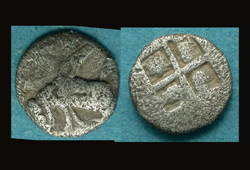Ave!
Roman Coffin Panel, USA Customers Only
Materiel - Cast lead 24 inches x 12 inches; weight, 25 pounds
Late 3rd – Early 4th Century AD
Description – All cast in very high relief with untouched lead patina
A monumental sarcophagus panel fragment featuring a band of acanthus leaves across the top.
Lower left – Four olive sprigs above and below, flanking a female winged sphinx who crouches right, her head facing. Single ivy leaf above.
Lower right – Two dolphins facing each other; below, a roundel of Helios/Sol Invictus; Single ivy leaf above. To either side, Corinthian columns.
Provenance - Ex Dr David MacDonald collection; Ex Harlan J Burk
From Dr MacDonald -
“The fragment and others came out of Lebanon during the 1970s. A group of Israeli soldiers during one of the periodic incursions into the area were digging trenches when they ran into a Roman burial ground containing a number of lead coffins, which they promptly saved and shipped back to Israel, from whence they were sold to the USA. I got it from Harlan J Berk in exchange for some work I did for him in the late 1970s or first years of the 1980s--do not remember the exact date, and it has been sitting in my office ever since.”
Symbology on the panel –
Acanthus Leaves - The acanthus is a vegetal motif rich in symbolism and has long been associated with the notion of rebirth. It is a symbol of immortality and resurrection, and as a decorative motif it has been used as early as 500 BCE
Sphinx – In Greek and later Roman tradition, the sphinx had the head of a woman, the haunches of a lion, and the wings of a fierce bird such as a falcon. She is mythicized as treacherous and merciless and will kill and eat those who cannot answer her riddle. This deadly version of a sphinx appears in the myth and drama of Oedipus. In both traditions, they were thought of as guardians and often flank the entrances to temples and tombs.
Dolphins - The ancient Greeks loved dolphins, and later to the the Romans as harbingers of Gook Luck. The Greeks named them philomousoi, music lovers, because they thought that dolphins danced when they heard music. Herodotus told a story about how the poet Arion was captured by pirates, jumped overboard, and was rescued by a dolphin and carried to shore.
Sol Invictus – Latin: "Unconquered Sun", sometimes known as Helios, has long considered to have been the official sun god of the later Roman Empire. The cult of Sol spread rapidly in the 3rd century, especially among the army, which favored the sub-cult of Sol Invictus.
Emperors portrayed SOL INVICTUS on their official coinage, with a wide range of legends, only a few of which incorporated the epithet INVICTUS, such as the legend SOLI INVICTO COMITI, claiming the "Unconquered Sun" as a companion to the emperor, used with particular frequency by Constantine. Statuettes of Sol Invictus, carried by the standard-bearers, appear in three places in reliefs on the Arch of Constantine. On March 7, 321 AD, Constantine decreed DIES SOLIS to be the day of the Sun, or “Sunday” – as the Roman day of rest.
Ivy Leaves - Ivy symbolizes fidelity (it won’t easily let go of something it’s attached itself to) and eternal life (because the plant is evergreen). In ancient Egypt ivy was dedicated to Osiris, who represented immortality. In ancient Greece and later ancient Rome, ivy was the plant of Dionysus because of its vigor. During long winters with little light, ivy in the home offered a spark of hope that spring would come again.
Olive sprigs and branches - Over the last 2,500 years, at least, they have been a symbol of Peace. In ancient times, an olive branch was held by supplicants to show their status when approaching persons of power or in temples asking the supplication the gods. Although peace was associated with the olive branch during the time of the Greeks, the symbolism became even stronger under the Pax Romana when envoys used olive branches as tokens of peace.
Bundling all this symbology together, we have representations of immortality and resurrection, fidelity to Sol and a resting peace, guarded by a Sphinx and dolphins singing in his ears, for the interred.
Who was interred in this sarcophagus?
He was certainly not a Christian in any manner, very wealthy and a pagan to the end of his life.
Seller's Note/ Such Roman Roman lead coffin panels are extremely rare, and the very few of them are now in museums. This is a once-in-life-time for you to not only purchase such an extremely rare Roman coffin lead artifact but to display in it your home collections!





